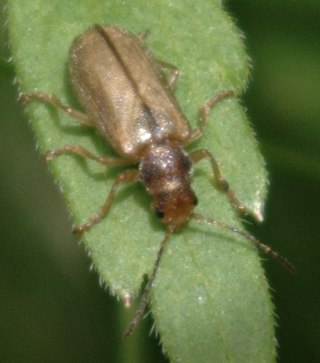
The Eumolpinae are a subfamily of the leaf beetles, or Chrysomelidae. It is one of the largest subfamilies of leaf beetles, including more than 500 genera and 7000 species. They are oval, and convex in form, and measure up to 10 mm in size. Typical coloration for this subfamily of beetles ranges from bright yellow to dark red. Many species are iridescent or brilliantly metallic blue or green in appearance.

The Synetinae are a small subfamily within the leaf beetle family (Chrysomelidae). They are found entirely within the Holarctic, mainly in North America but also appearing in parts of Europe and Asia. The subfamily contains only two genera, Syneta and Thricolema, with a total of 12 described species. The group is sometimes treated as a tribe of Eumolpinae, where they are known as Synetini.
Catiniidae is a small extinct family of beetles known from the Early Triassic to the Early Cretaceous. The family is usually classified as a member of the suborder Archostemata, but beetles in this family had smooth elytra unlike members of the modern-day families Cupedidae and Ommatidae which have elytra with window punctures.

Alleculinae is a subfamily of comb-clawed beetles belonging to the family Tenebrionidae. These beetles are characterized by an oval body, threadlike antennae, relatively long legs and tarsi quite elongated. Their most striking feature, however, are the combed claws of the hind tarsi, that show fine teeth.

Psammodiini is a tribe of aphodiine dung beetles in the family Scarabaeidae. There are more than 30 genera and 470 described species in Psammodiini.

Diaperinae is a subfamily of darkling beetles in the family Tenebrionidae. There are more than 120 genera in Diaperinae, grouped into 11 tribes.

Eumolpini is a tribe of leaf beetles in the subfamily Eumolpinae. It is the largest tribe in the subfamily, with approximately 170 genera found worldwide. Members of the tribe almost always have a longitudinal median groove on the pygidium, which possibly helps to keep the elytra locked at rest. They also generally have a subglabrous body, as well as appendiculate pretarsal claws.

Typophorini is a tribe of leaf beetles in the subfamily Eumolpinae. The tribe contains approximately 100 genera, which are found worldwide. Members of the tribe are mainly characterized by notches on the tibiae of the middle and hind legs, which are sometimes referred to as antenna cleaners. They also generally have a subglabrous body, as well as bifid pretarsal claws.

Euryope is a genus of leaf beetles in the subfamily Eumolpinae. It is distributed in Africa and the Arabian Peninsula.

Chrysochus is a genus of leaf beetles in the subfamily Eumolpinae. It is known from North America, Europe and Asia.
Edusella is a genus of leaf beetles in the subfamily Eumolpinae. It mainly occurs in Australia, with a single species occurring in New Caledonia.

Euryopini is a tribe of leaf beetles in the subfamily Eumolpinae.

Bromiini is a tribe of leaf beetles in the subfamily Eumolpinae. The tribe contains approximately 120 genera, which are found worldwide. They are generally thought to be an artificial group, often with a subcylindrical prothorax without lateral ridges and covered with setae or scales.
Odontionopa is a genus of leaf beetles in the subfamily Eumolpinae. It is distributed in Africa.

Thasycles is a genus of leaf beetles in the subfamily Eumolpinae. It is endemic to New Caledonia. For a long time it was treated as a synonym of Dematochroma, until it was reinstated as a valid genus in 2022.
Odontolochini is a tribe of scarab beetles in the family Scarabaeidae. There are about 6 genera and more than 20 described species in Odontolochini, found in the Neotropics, Australia, and Africa.

Rhyparini is a tribe of scarab beetles in the family Scarabaeidae. There are about 14 genera and more than 120 described species in Rhyparini.
Termitoderini is a tribe of scarab beetles in the family Scarabaeidae. There are at least two genera and about six described species in Termitoderini. They are found in tropical Africa.
Aulonocneminae is a subfamily of scarab beetles in the family Scarabaeidae. There are about 5 genera and more than 50 described species in Aulonocneminae, found in Madagascar and east Asia.

Lichniinae is a subfamily of scarab beetles in the family Scarabaeidae. The subfamily consists of two genera and about six described species. Lichniinae is sometimes considered a tribe of the subfamily Melolonthinae, Lichniini.














